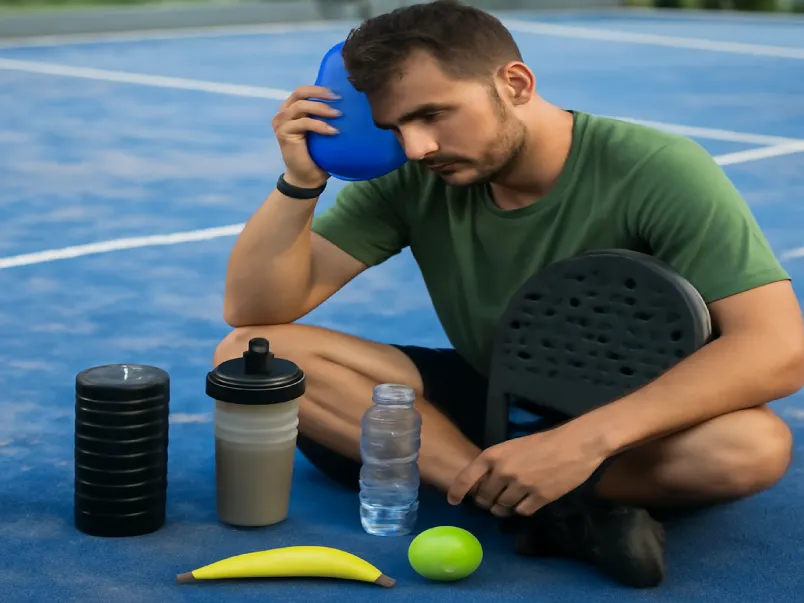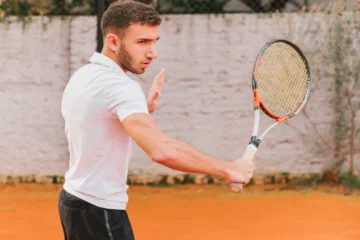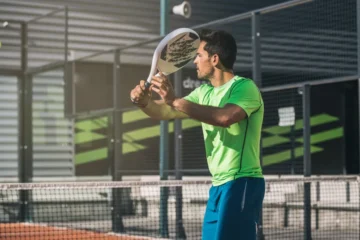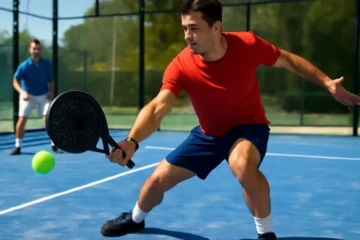Imagine the intensity of a padel match: the explosive movements, the rapid pivots, and the mental focus required to stay ahead of your opponent. Whether you’re playing for fun or competing at a high level, padel demands a combination of speed, strength, and mental acuity. But here’s the catch: as much as the physical effort during a match is critical to your success, what you do after the final point is just as important. In fact, recovery is often the secret weapon to not only surviving the next match but thriving in it.
In a sport as demanding as padel, proper recovery is the key to longevity, injury prevention, and consistent performance. Whether you’re a seasoned pro or just starting, your recovery protocol can make the difference between playing at your peak and being sidelined with an injury. This article will guide you through the essential phases and methods of an effective recovery routine, ensuring you stay on top of your game.
I. The Immediate Aftermath: The “Golden Hour” (0-60 Minutes Post-Match)
The first 60 minutes after a match is often referred to as the “golden hour.” It’s a critical window where the body is primed to repair itself, and the right steps can significantly influence how quickly you bounce back for your next challenge.
A. Cool-Down & Light Movement
Why it’s important: Intense activity causes blood to pool in your muscles, which can contribute to soreness and discomfort. Cooling down with light movement helps flush out metabolic waste, reduces muscle stiffness, and facilitates recovery.
What to do: Engage in 5-10 minutes of light jogging or walking. Dynamic stretching can also be effective, particularly to mobilize the joints and muscle groups used heavily during the match, such as your hips, knees, and shoulders.
B. Hydration: Replenishing Fluids & Electrolytes
Padel is an intense sport that involves quick bursts of energy, leading to significant fluid loss through sweat. Dehydration not only impairs performance but also hinders the recovery process.
The goal: Replace the fluids lost during the match, including important electrolytes like sodium, potassium, and magnesium.
What to do: Drink water with added electrolyte tablets or opt for natural hydration sources like coconut water. A small, balanced snack or meal that includes hydrating ingredients, such as fruits, can also be beneficial.
C. Nutrition: The Anabolic Window
Post-match nutrition is critical to kick-start the recovery process. The body enters an anabolic window, a period where muscles are particularly receptive to nutrients. This is the best time to refuel.
The goal: Replenish glycogen stores and provide protein for muscle repair. Glycogen is the primary energy source used during exercise, and the muscle fibers need protein to rebuild and repair after the intense activity.
What to eat: Aim for a carbohydrate-to-protein ratio of 3:1 or 4:1. Some great post-match options include a protein shake with a banana, chocolate milk, or Greek yogurt with some fruit.
II. The Next 24 Hours: Active Recovery and Repair
Once you’ve addressed the immediate recovery needs, the next 24 hours are crucial for repair and restoration. Active recovery methods should be incorporated into this phase to help reduce soreness and improve circulation.
A. Managing Inflammation and Soreness
Muscle soreness and inflammation (Delayed Onset Muscle Soreness or DOMS) can be a result of the stress placed on the body during the match. These symptoms are normal but need to be managed effectively for faster recovery.
Cryotherapy: Ice baths or cold water immersion (10-15 minutes) can help reduce inflammation and alleviate muscle soreness. Cold exposure limits blood flow to the muscles, reducing swelling and pain.
Contrast Therapy: Alternating between hot and cold showers (or baths) can stimulate blood flow and help flush toxins from the muscles, aiding in quicker recovery.
Compression Garments: Wearing compression tights or sleeves can enhance circulation and reduce swelling, which can contribute to faster recovery.
B. The Power of Sleep
Sleep is when the body performs most of its recovery work. While you may think of sleep as a passive process, it’s actually highly active, with the body repairing muscles, tissues, and replenishing energy stores.
Quality over Quantity: The key is not just the number of hours you sleep but the quality of that sleep. Deep, restorative sleep is where the body releases growth hormones, which are essential for tissue repair and muscle recovery.
Tips for Better Sleep: Aim for a cool, dark room and establish a consistent sleep schedule. Avoid screens and blue light exposure at least an hour before bed to allow your body to naturally wind down.
C. Movement is Medicine: Active Recovery
While rest is important, complete immobility can sometimes be counterproductive. Active recovery helps to maintain blood circulation and speed up the healing process.
What to do: Engage in low-impact activities like walking, swimming, cycling, or light padel drills. These activities help promote blood flow without placing excessive stress on the muscles.
What to avoid: Intense, high-impact exercises that could exacerbate muscle damage and hinder recovery.
III. Specialized Recovery Techniques for the Modern Padel Athlete
For athletes who want to take their recovery to the next level, there are specialized techniques that can enhance the process and support quicker recovery.
A. Professional Body Maintenance
Sports Massage: A deep tissue massage or sports massage can help break down muscle adhesions and knots, improving flexibility and relieving tension. Common target areas for padel players are the shoulders, quads, and calves.
Physiotherapy: Regular visits to a physiotherapist can help identify and address minor injuries or movement imbalances before they escalate into something more serious.
B. Mobility and Flexibility Work
Padel requires agility and flexibility, particularly in the hips, shoulders, and thoracic spine. These areas are prone to tightness and restricted mobility, so dedicated flexibility work can greatly enhance performance.
Methods: Incorporate dynamic stretching before your session and static stretching or yoga post-session to improve your range of motion and reduce muscle stiffness.
C. Modern Tech & Tools
Foam Rollers & Lacrosse Balls: These self-myofascial release tools help break down muscle tightness and improve circulation to aid recovery. Focus on the quads, hamstrings, back, and calves for the best results.
Percussion Massage Guns: These devices provide deep tissue massage to specific muscle groups, improving blood flow and relieving muscle tightness. They can be particularly helpful in targeting tight areas that are hard to reach with traditional stretching or foam rolling.
IV. The Often-Forgotten Element: Mental Recovery
While physical recovery is a top priority, mental recovery is equally important in a high-intensity sport like padel. The mental demands of the game can be taxing, and giving the brain a chance to recover can significantly improve overall performance.
A. Debriefing the Match
After a match, it’s essential to reflect on your performance constructively. This can help you learn from mistakes and adjust your strategies for the future. However, it’s equally important to avoid ruminating over mistakes or losses.
What to do: Take a few moments to review your match performance, focusing on areas for improvement. Then, let it go. The goal is to focus on learning rather than dwelling on what didn’t go well.
B. Mental Downtime
Just like your muscles, your brain needs downtime to recover from the demands of the game. Engaging in activities that are unrelated to padel can provide this mental reset.
Techniques: Meditation, mindfulness, or simply taking time to engage in hobbies outside of sport can be incredibly effective in maintaining mental balance.
Digital Detox: After a match, avoid consuming competitive sports content on social media or watching videos of your opponents. Giving your mind a break from the constant flow of sports stimuli can prevent mental burnout.
V. Building a Personalized Recovery Plan
One of the most important aspects of recovery is understanding that it is not one-size-fits-all. Your recovery plan should be tailored to your individual needs, playing style, and intensity of your training or competition.
Listen to Your Body
The most important rule: Soreness after a match is normal, but sharp pain is not. Always listen to your body’s signals and seek professional advice if something doesn’t feel right.
Recovery is Not One-Size-Fits-All: A professional athlete may need a more intricate recovery protocol than someone playing casually. The key is to create a routine that works for you and your specific needs.
Sample Recovery Timeline:
- Immediate (0-1 hr): Cool-down, hydrate, and eat a recovery snack.
- Evening (Post-Match): Light meal, contrast therapy, and an early night’s sleep.
- Next Day: Active recovery (e.g., walking or swimming), mobility work, and possibly a sports massage.
- 48 Hours Later: Return to training when the body feels ready.
Conclusion
In padel, recovery is more than just a passive phase—it’s an essential part of your athletic routine. By focusing on immediate refueling, active recovery, professional body care, and mental rest, players can ensure they stay at their best, preventing injuries and improving performance in the long run.
Remember, recovery is an investment in your future performance. By dedicating time and effort to your recovery protocol, you’re not only helping your body heal but also setting yourself up to perform better, play longer, and enjoy the game you love for many years to come.
FAQs
1. Why is recovery important for padel players?
Recovery is essential for padel players because it helps to prevent injuries, repair muscle tissues, replenish energy stores, and maintain consistent performance. Proper recovery allows athletes to perform at their best in future matches and ensures long-term fitness.
2. What is the “golden hour” in recovery?
The “golden hour” refers to the first 60 minutes after a match, where the body is highly receptive to nutrient replenishment and repair. It’s crucial to cool down, hydrate, and consume a balanced meal to kick-start the recovery process during this time.
3. How can I reduce muscle soreness after playing padel?
To reduce muscle soreness, consider using techniques like cryotherapy (cold baths), contrast therapy (alternating hot and cold showers), and wearing compression garments. These methods help manage inflammation and promote blood circulation for quicker recovery.
4. Is sleep really that important for recovery in padel?
Yes, sleep is critical for recovery. During deep sleep, the body releases growth hormones that repair muscles, regulate hormones, and help restore energy levels. Quality sleep aids faster recovery and overall performance.
5. How can I recover mentally after a padel match?
Mental recovery is just as important as physical recovery. Engage in activities such as meditation, mindfulness, or taking a digital detox to unwind. Constructively reflect on your match performance, focusing on learning from your mistakes, rather than ruminating on them.
6. What are the best post-match snacks for padel recovery?
Ideal post-match snacks should have a 3:1 or 4:1 carbohydrate-to-protein ratio. Some great options include a protein shake with a banana, chocolate milk, or Greek yogurt with fruit. These provide the necessary nutrients for muscle repair and glycogen replenishment.
7. How often should I get a sports massage for recovery?
Sports massages can be beneficial for relieving muscle tightness and improving flexibility. Depending on your training intensity and schedule, getting a sports massage 1-2 times a week can help maintain muscle health and prevent injury.




